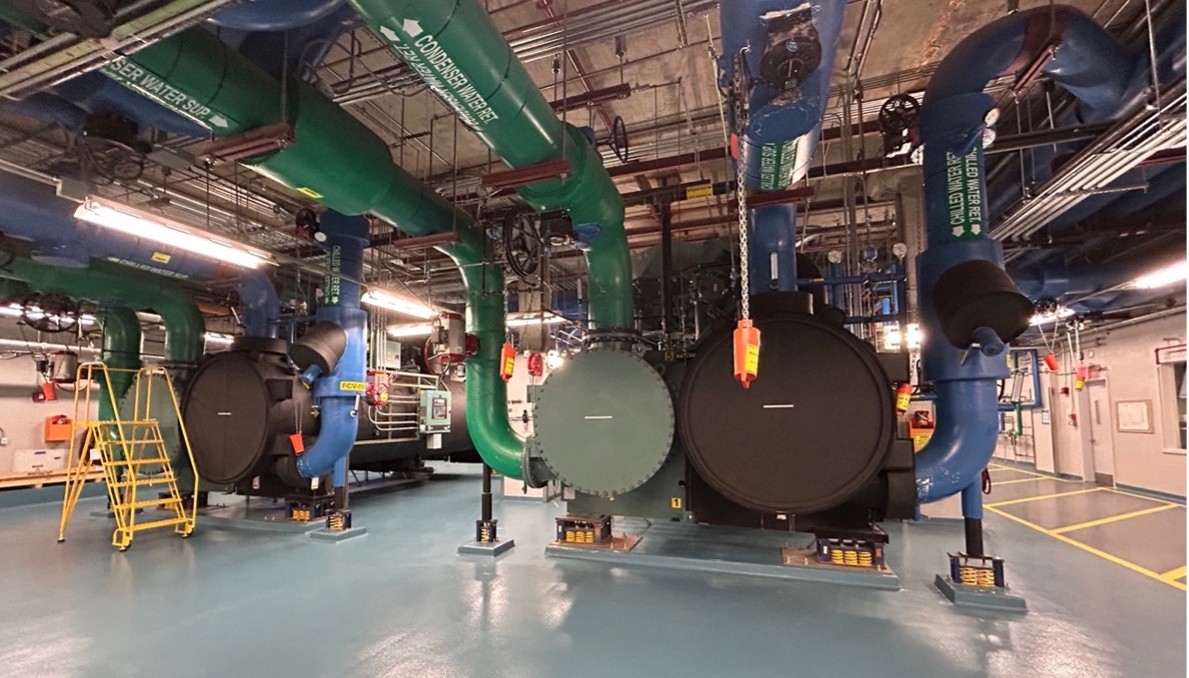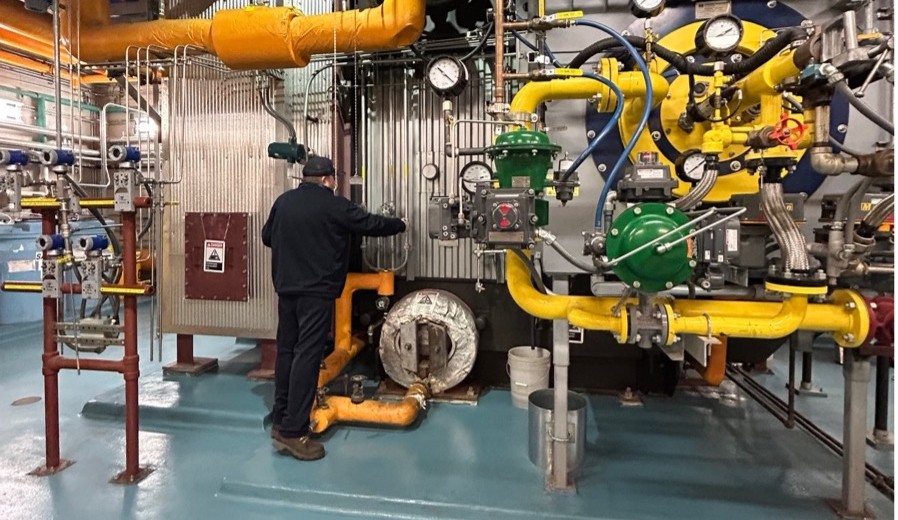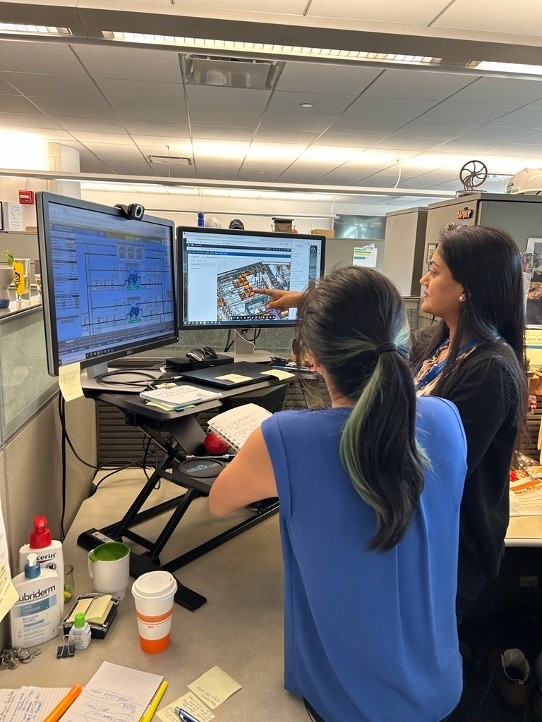Manhattanville’s District Energy Systems Team Uses Data-Driven Measures to Reduce the Campus’s Footprint and Contribute to University Sustainability Plan
Learn how the District Energy Systems team, a division of Facilities and Operations, uses data to reduce emissions in the short-term while working to upgrade the Central Energy Plant to meet rigorous new standards.

Columbia’s Manhattanville campus—located from 125th Street to 133rd Street, between Broadway and 12th Avenue—is a hub of innovation, from its groundbreaking Zuckerman Institute to its state-of-the-art Business School. The central energy plant that powers the campus reflects this innovation, not only in its original design (which was award-winning) but in the day-to-day work of Columbia’s District Energy Systems team that works to minimize its footprint.
A core value of both the Manhattanville campus plan and the design of each new building is environmental sustainability, from the materials employed to the creative use of natural light and air flow. A Central Energy Plant (CEP) beneath the campus is far more energy efficient than the traditional approach, which requires boilers and stacks for each building.
This single, central location that provides chilled water, high pressure steam, and normal electric power service across the Manhattanville campus is located below the Lenfest Center for the Arts and the Plaza. The CEP includes a refrigeration plant, high-efficiency dual fuel-fired (oil and natural gas) boiler plant, normal electric power service from Con Edison, a robust emergency/standby/diesel generator plant, and associated support and advanced control systems. The emergency power generator is located on the roof of the Studebaker building.

The initial Manhattanville campus plan was designed with core sustainability principles. However, the landscape has evolved since the CEP was built in 2015. Columbia University released its newest sustainability plan in 2021, which placed more stringent emissions reduction requirements in line with the plan’s science-based targets and Local Law 97 (which requires large existing buildings in New York City to reduce their emissions by 40% by 2030 and 80% by 2050).
What started as a boiler plant designed for four boilers now must be remodeled to pull from alternate heating sources like air and geothermal and include fully electric chillers. The District Energy Systems team is working on a new design for the CEP that will incorporate these renewable sources in the long-term while implementing data-driven energy control measures in the short-term.
“We’re always looking at data to see how we can minimize our footprint,” said Michael Haeser, Director for District Energy Systems at Columbia’s Manhattanville Campus. “We try things and look at the data to see if it worked and, if not, we try something else. We’re also very focused on doing what we can do right now while we plan for the future.”
Some of these energy control measures include:
- Looking at kilowatts per ton and LB steam/KCF of natural gas to increase efficiency
- Free-cooling: using cooling towers to naturally decrease the temperature of chiller water
- When running electric chillers, using the minimum flow rate rather than the standard rate to lower the kilowatt per ton impact
District Energy Systems strives to reduce the amount of energy at both the source-side and the building-side wherever they can. They contract with a third party called UtiliVisor to archive their energy systems data, which uses a sophisticated dashboard to display trends.

Haeser said the team often collaborates with other Facilities and Operations departments like the Manhattanville Development Group at Columbia to ensure all University efforts are coordinated, and that teams are learning from one another as new requirements come online.
“Every department on every campus at Columbia contributes to the overall sustainability of the University,” said Haeser. “We believe in the importance of educating our campus community on the different forms of energy that exists in their day-to-day activities, and the difficulties of the Facilities teams to reduce our carbon footprint without compromising the student experience and affecting the campus’s productivity.”

More About Columbia’s Sustainability Plan
Plan 2030 is a ten-year strategic plan that outlines aggressive sustainability goals, grounded in climate science, for Columbia’s New York campuses to achieve net zero emissions by 2050.
Plan 2030’s Campus Energy goal articulates the University’s commitment to electrification and 100% renewable electricity. Columbia’s strategy is to transition as rapidly as is practical from brown power paired with RECs to zero-emission electric sources on the New York grid.
Read more about campus energy and greenhouse gas emissions on the Sustainable Columbia website: https://sustainable.columbia.edu/energy
More About Columbia’s Manhattanville Campus
Designed to fit within the existing street grid on the blocks along Broadway west to 12th Avenue from the triangle where 125th Street crosses 129th Street north to 133rd Street—and on the east side of Broadway from 131st to 134th Street—the campus plan encompasses more than 17 acres with publicly accessible open space, tree-lined sidewalks and innovative buildings whose very transparency encourages shared knowledge and social engagement.
The Manhattanville campus’s environmentally sustainable design and overall project plan achieved Stage 1 LEED Platinum certification under the U.S. Green Building Council’s Neighborhood Development pilot rating system—the highest designation in the rating system. It is the first such award in New York City and the first given to a campus plan anywhere in the United States.
Read more about the sustainability of the Manhattanville campus on the Columbia Neighbors website: https://neighbors.columbia.edu/content/sustainability
